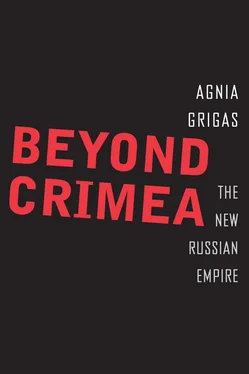The last set of country case studies, Belarus and Armenia, is dealt with in Chapter 7. These states have been among Russia’s closest allies since their independence and offer a unique perspective on how Moscow’s compatriot-driven reimperialization policies can be pursued in highly cooperative, dependent, and vulnerable post-Soviet states. The analysis demonstrates that such states are less able to resist both Russia’s softer and its more coercive means of influence, so that they are maintained de facto in Russia’s imperial project without the need to resort to outright aggression.
The conclusion summarizes the progression of Moscow’s compatriot-driven expansionism from the most clear and current examples to future risk cases in Russia’s neighborhood. I argue that Moscow has succeeded in implementing its reimperialization trajectory in Ukraine, Georgia, Moldova; made notable progress in the Baltic States; reaped many benefits in Armenia and Belarus; and largely fallen short in Central Asia. I also assess the long-term consequences of Russia’s neo-imperialist policies, including frozen conflicts and the muted ability of the territorially jeopardized countries to lead independent foreign policies. Finally I consider the implications of the book’s findings for Western policy toward Russia and Russian compatriots as well as focus on near abroad countries’ policies toward their Russophone and other minorities.
CHAPTER TWO
Russian Reimperialization
FROM SOFT POWER TO ANNEXATION
[Putin] talks about the need to rebuild the world order, about Russia’s birthright to its own sphere of influence, about the necessity of protecting the Russian minorities abroad. The Kremlin uses minorities, language and cultural issues to blow up the neighboring countries from the inside.
—Boris Nemtsov, February 2015
THE COLLAPSE OF THE SOVIET UNION was a joyous occasion for many people from the fourteen subjugated Soviet republics, including many Russians who sought to transform the Russian Federation into a civic state out of the rubble of an empire. However, for some of the old guard of the Kremlin, the dissolution of the Union was a disaster that in a fortnight wiped out a superpower of some 293 million Soviet citizens and some eight and a half million square miles that stretched from the European continent to China. The early years of the fledgling Russian democracy under President Boris Yeltsin were marked by painful reforms and an economic slump that was in no small part due to the low global oil prices of the 1990s. 1Under the leadership of Yeltsin and his first foreign minister, Andrey Kozyrev (1991–96), there was an effort to leave behind Russia’s imperial ambitions—demonstrated by the withdrawal of Russian troops from Eastern Europe in the early 1990s, cuts in military spending, recognition of the borders of Russia’s neighbors, and in the case of Ukraine, letting Kiev keep part of the Black Sea Fleet while not encouraging Crimea’s separatists. However, the emergence of strong-man President Vladimir Putin in 1999 and growing wealth from rising global oil prices reignited Moscow’s drive to rebuild Russia’s lost power and influence based on the historical legacies of the Soviet Union and even the Romanov empire. Indeed, there was an effort to extend Moscow’s sphere of influence (if not its actual territory) to match the borders of the historical Russian empire. As Putin noted in January 2012, the Soviet Union “actually was Great Russia whose base formed back in the 18th century.” 2
This chapter sets forth the central argument of this book, proposing that the Russian government, especially during the regime of Vladimir Putin, has consistently used ethnic Russians and Russian speakers residing abroad to extend its influence and expand its borders at opportune domestic and international moments with the aim of reimperialization of the former Soviet space. Reimperialization is the end of Moscow’s policies. The Russian diaspora—reconstructed politically as compatriots—has been the means. Since the early 1990s, and particularly the mid-2000s, Moscow has wooed the Russian diaspora, conceptualized it as Russian compatriots, and sought to unite it in a “Russian World” and provide it with Russian passports. Rhetorical, diplomatic, and even military protection of the Russian compatriots and the newly minted citizens has followed. Eventually, on a number of occasions, compatriots were exploited to achieve Russia’s territorial ambitions in the post-Soviet space. In the cases of eastern Ukraine and Crimea as well as Georgia’s South Ossetia and Abkhazia, this has resulted in outright or de facto annexation of territories where Russian compatriots and Russian speakers reside. To a lesser extent, the same is true for Moldova’s Transnistria. Many similar processes vis-à-vis Russian compatriots are under way in Estonia, Latvia, Lithuania, Belarus, Kazakhstan, and other states in Russia’s near abroad.
I propose that Moscow has pursued an increasingly consistent seven-stage reimperialization policy trajectory toward its compatriots, moving from (1) soft power to (2) humanitarian policies, (3) compatriot policies, (4) passportization, (5) information warfare, (6) protection, and (7) informal control or formal annexation of the territories where the compatriots reside. This trajectory starts with Russia’s cultural, economic, and linguistic influence over compatriot populations and their target states. Subsequently or simultaneously, Moscow pursues humanitarian policies of aid and support for the various rights of Russian speakers in foreign states unilaterally, bilaterally, and via multilateral institutions. Then the politically reconstructed diaspora community of compatriots is institutionalized and formalized through various policies, including laws, programs, and organizations, such as the Russian state–funded Russkiy Mir (Russian World) Foundation and the Russkiy Dom (Russia House) network. Policies of passportization—offering Russian citizenship to ethnic Russians, Russian speakers, and other minorities residing in specific territories of the former Soviet republics—create concentrated groups of Russian citizens outside Russia’s borders. Then the conditions are set for Moscow’s information warfare campaign targeted at domestic, foreign, and compatriot audiences that proclaims an “urgent” need for the protection of Russian compatriots and citizens in foreign territories. The final stage is fueling of separatism that results in Moscow’s outright annexation or control of the territories where the compatriots reside. Some of the seven stages of this reimperialization trajectory can overlap, occur simultaneously, or occur in a slightly different order. The general trajectory, however, moves from co-optation of ethnic Russians and Russian speakers to territorial expansion under the guise of compatriot or minority protection, all under the veil of a blitz of information warfare.
Rather than a timetable or a formalized set of policies, the proposed seven-phase scenario reveals the aims of and provides context for the seemingly disparate Russian policies that until now have been under the radar. This is not a timetable to predict if and when Moscow will seek military protection of Russian compatriots and territorial annexation in, say, Kazakhstan or Estonia. However, the scenario signals that if a state has already been a target of the previous five phases of soft power, humanitarian, compatriot, passportization, and information policies, then the groundwork has been laid for potentially more aggressive tactics in the future. Across all former Soviet republics, Russia has already achieved various degrees of success with these policies from country to country. Still, annexation is far from a certain outcome but rather a possibility. Likewise, despite consistent policies to lay the groundwork for influence and control over territories where Russian compatriots reside, Moscow’s specific policy outcomes cannot be predicted or guaranteed.
Читать дальше












